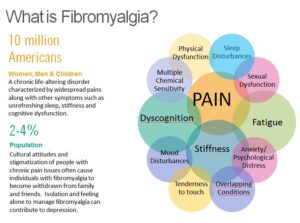What is this disorder?
Fibromyalgia is a common neurologic health problem that causes widespread pain and tenderness (sensitivity to touch). This invisible, life-altering condition causes 2-4% of women, men and children of all backgrounds worldwide to suffer. (That’s 10 million Americans alone.) The disorder can strike suddenly or occur as a gradual increase in symptoms, indicating changes in the central nervous system (neuroplasticity). Sensory information (such as light, sound, and touch) becomes amplified by the CNS, causing the brain to respond with increasing pain and symptoms. FM severity often increases over time and may become disabling.
The pain and tenderness tend to come and go, and move about the body. Most often, people with this chronic (long-term) illness are fatigued (very tired) and have sleep problems. The diagnosis can be made with a careful examination.
Fibromyalgia is most common in women, though it can occur in men. It most often starts in middle adulthood, but can occur in the teen years and in old age. You are at higher risk for fibromyalgia if you have a rheumatic disease (health problem that affects the joints, muscles and bones). These include osteoarthritis, lupus, rheumatoid arthritis, or ankylosing spondylitis.
Fibromyalgia is a disorder characterized by widespread musculoskeletal pain accompanied by fatigue, sleep, memory and mood issues. Researchers believe that fibromyalgia amplifies painful sensations by affecting the way your brain processes pain signals.
Causes:
The causes of fibromyalgia are unclear. They may be different in different people. Current research suggests involvement of the nervous system, particularly the central nervous system (brain and spinal cord). Fibromyalgia is not from an autoimmune, inflammation, joint, or muscle disorder. Fibromyalgia may run in families. There likely are certain genes that can make people more prone to getting fibromyalgia and the other health problems that can occur with it. Genes alone, though, do not cause fibromyalgia.
There is most often some triggering factor that sets off fibromyalgia. It may be spine problems, arthritis, injury, or other type of physical stress. Emotional stress also may trigger this illness. The result is a change in the way the body “talks” with the spinal cord and brain. Levels of brain chemicals and proteins may change. More recently, Fibromyalgia has been described as Central Pain Amplification disorder, meaning the volume of pain sensation in the brain is turned up too high.
Although Fibromyalgia can affect quality of life, it is still considered medically benign. It does not cause any heart attacks, stroke, cancer, physical deformities, or loss of life.
While there is no cure for fibromyalgia, a variety of medications can help control symptoms. Exercise, relaxation and stress-reduction measures also may help.
Stay tune for Part II Monday on Signs, Symptoms and more!

